“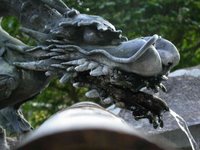 Here, the glory of three generations of the Fujiwara clan passed away like a fleeting dream (…) Only Mt Kinkei remained. I climbed the hill where Yoshitsune died; I saw the Kitakami, a broad stream flowing down through the Nambu Plain, the Koromo River circling Izumi Castle below the hill before joining the Kitakami…”
Here, the glory of three generations of the Fujiwara clan passed away like a fleeting dream (…) Only Mt Kinkei remained. I climbed the hill where Yoshitsune died; I saw the Kitakami, a broad stream flowing down through the Nambu Plain, the Koromo River circling Izumi Castle below the hill before joining the Kitakami…”
Yoshitsune is one of the best-loved tragic samurai figures in Ja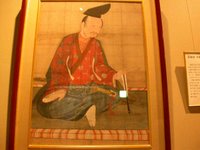 panese history. After securing a succession of bold and crucial victories for his elder brother, Miramoto no Yoritomo, in their fight for the shogunate, he fell out
panese history. After securing a succession of bold and crucial victories for his elder brother, Miramoto no Yoritomo, in their fight for the shogunate, he fell out 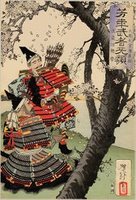 with him and was forced to flee north to the protection of the Fujiwara Clan. The Shogunate eventually came after him and his protectors, sacked, burnt and pillaged the lot, and that was that.
with him and was forced to flee north to the protection of the Fujiwara Clan. The Shogunate eventually came after him and his protectors, sacked, burnt and pillaged the lot, and that was that.
Basho had Yoshitsune constantly in mind during his travels, and most of the rest of his trip was in fact a mirror image of Yoshitsune’s epic flight for sanctuary.
I stood at the railings at Takadachi-gideo, right where Basho wrote perhaps his most famous verse:
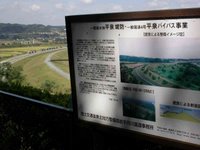 om the left, the crescent-shaped sandbank on the far side of the Kitakami, the bulk of Kinkei mountain, looming against the sky in front ... and a massive great by-pass being built right in front of me!
om the left, the crescent-shaped sandbank on the far side of the Kitakami, the bulk of Kinkei mountain, looming against the sky in front ... and a massive great by-pass being built right in front of me!
I am going to protest! I have a duty as a poet to protest! I could be the last poet to stand here and see what Yoshitsune saw as his blood stained the ground and his sight dimmed! How DARE they build a by-pass in front of it??!? This is a rape of Japan’s cultural history!
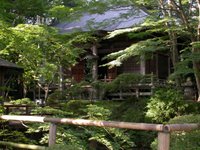 tly hired bike and peddle madly down and across to Choson-ji.
tly hired bike and peddle madly down and across to Choson-ji.
Choson-ji was founded in 850 by the Tendai Buddhist sect, and then extended by the first Fujiwara lord into a vast complex of over 40 temples and 300 buildings. Most of the complex was ravaged by a fire in 1337.
There is a Jamaican connection here, believe it or not. Marco Polo returned from China in the 13th century bearing travellers’ tales of ‘the fabled islands of Zipong’ (Japan) and ‘The Golden Hall of Hiraizumi’. One Christopher Columbus picked up on these. He determined to make his name (and fortune) and find the fabled hall by travelling west to the Orient, avoiding the almost total economic blockade by Muslim S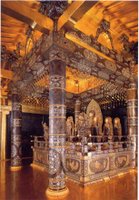 tates of the way to the East. It took some time to find a sponsor for this doubtful venture, but eventually the Spanish Queen, Isabel, prevailed on her husband to bankroll the trip, and, in 1492, a date indelibly fixed in every West Indian schoolboy's mind through the memonic “in 1492 / Columbus sailed the blue”, he made landfall in the Bahamas, believing he’d reached ‘The Indies’. Hence ‘The West Indies’ and the start of the European exploitation of the islands, the growing of sugar-cane, slavery, buccaneering, expansionism, why we play cricket in Jamaica and all that jazz.
tates of the way to the East. It took some time to find a sponsor for this doubtful venture, but eventually the Spanish Queen, Isabel, prevailed on her husband to bankroll the trip, and, in 1492, a date indelibly fixed in every West Indian schoolboy's mind through the memonic “in 1492 / Columbus sailed the blue”, he made landfall in the Bahamas, believing he’d reached ‘The Indies’. Hence ‘The West Indies’ and the start of the European exploitation of the islands, the growing of sugar-cane, slavery, buccaneering, expansionism, why we play cricket in Jamaica and all that jazz.
Konjikido – the actual Golden Hall - dates from 1124 and is housed under a protective outer wooden structure from well before the 17th century Basho. This, in turn, is housed under a modern protective shell. Layer on layer. The Japanese wrap things in layers, boxes. They wrap t hemselves in layers, boxes. Kimonos consist of an exquisity of multiple layers. Their famed lacquerware consists of layer after painstakingly applied layer of lacquer. Their society itself consists of layers, boxes.
hemselves in layers, boxes. Kimonos consist of an exquisity of multiple layers. Their famed lacquerware consists of layer after painstakingly applied layer of lacquer. Their society itself consists of layers, boxes.
Konjikido itself is golden, marvellous - but, like Basho at Zuiganji, I am distracted by the shuffling day-trippers, the tour guides, the loudspeakers; there’s too much gold, too much veneration.
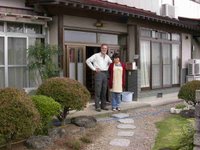
Basho wrote: ‘Jewelled doors battered by winds; gold pillars cracked by cold, all would have gone to grass, but added outer roof and walls protect it. Through the endless winds and rains of a thousand years, this great hall remains.’
I write:
 Here, the glory of three generations of the Fujiwara clan passed away like a fleeting dream (…) Only Mt Kinkei remained. I climbed the hill where Yoshitsune died; I saw the Kitakami, a broad stream flowing down through the Nambu Plain, the Koromo River circling Izumi Castle below the hill before joining the Kitakami…”
Here, the glory of three generations of the Fujiwara clan passed away like a fleeting dream (…) Only Mt Kinkei remained. I climbed the hill where Yoshitsune died; I saw the Kitakami, a broad stream flowing down through the Nambu Plain, the Koromo River circling Izumi Castle below the hill before joining the Kitakami…” Yoshitsune is one of the best-loved tragic samurai figures in Ja
 panese history. After securing a succession of bold and crucial victories for his elder brother, Miramoto no Yoritomo, in their fight for the shogunate, he fell out
panese history. After securing a succession of bold and crucial victories for his elder brother, Miramoto no Yoritomo, in their fight for the shogunate, he fell out  with him and was forced to flee north to the protection of the Fujiwara Clan. The Shogunate eventually came after him and his protectors, sacked, burnt and pillaged the lot, and that was that.
with him and was forced to flee north to the protection of the Fujiwara Clan. The Shogunate eventually came after him and his protectors, sacked, burnt and pillaged the lot, and that was that.Basho had Yoshitsune constantly in mind during his travels, and most of the rest of his trip was in fact a mirror image of Yoshitsune’s epic flight for sanctuary.
I stood at the railings at Takadachi-gideo, right where Basho wrote perhaps his most famous verse:
Summer grassesHere Yoshitsune killed himself when all was lost. Here Basho ‘sat down on his hat and wept bitterly till he almost forgot time’. I saw what Yoshitsune saw as he died: the broad sweep of the River Kitakami, its tributary, Koromogawa, coming in fr
All that is left of great warriors’
Imperial dreams
 om the left, the crescent-shaped sandbank on the far side of the Kitakami, the bulk of Kinkei mountain, looming against the sky in front ... and a massive great by-pass being built right in front of me!
om the left, the crescent-shaped sandbank on the far side of the Kitakami, the bulk of Kinkei mountain, looming against the sky in front ... and a massive great by-pass being built right in front of me!I am going to protest! I have a duty as a poet to protest! I could be the last poet to stand here and see what Yoshitsune saw as his blood stained the ground and his sight dimmed! How DARE they build a by-pass in front of it??!? This is a rape of Japan’s cultural history!
Rampant on horseInfuriated and saddened at the same time, I jump on my rat
Yoshitsune
Rampant on dumper truck
Highways Development Agency
 tly hired bike and peddle madly down and across to Choson-ji.
tly hired bike and peddle madly down and across to Choson-ji.Choson-ji was founded in 850 by the Tendai Buddhist sect, and then extended by the first Fujiwara lord into a vast complex of over 40 temples and 300 buildings. Most of the complex was ravaged by a fire in 1337.
There is a Jamaican connection here, believe it or not. Marco Polo returned from China in the 13th century bearing travellers’ tales of ‘the fabled islands of Zipong’ (Japan) and ‘The Golden Hall of Hiraizumi’. One Christopher Columbus picked up on these. He determined to make his name (and fortune) and find the fabled hall by travelling west to the Orient, avoiding the almost total economic blockade by Muslim S
 tates of the way to the East. It took some time to find a sponsor for this doubtful venture, but eventually the Spanish Queen, Isabel, prevailed on her husband to bankroll the trip, and, in 1492, a date indelibly fixed in every West Indian schoolboy's mind through the memonic “in 1492 / Columbus sailed the blue”, he made landfall in the Bahamas, believing he’d reached ‘The Indies’. Hence ‘The West Indies’ and the start of the European exploitation of the islands, the growing of sugar-cane, slavery, buccaneering, expansionism, why we play cricket in Jamaica and all that jazz.
tates of the way to the East. It took some time to find a sponsor for this doubtful venture, but eventually the Spanish Queen, Isabel, prevailed on her husband to bankroll the trip, and, in 1492, a date indelibly fixed in every West Indian schoolboy's mind through the memonic “in 1492 / Columbus sailed the blue”, he made landfall in the Bahamas, believing he’d reached ‘The Indies’. Hence ‘The West Indies’ and the start of the European exploitation of the islands, the growing of sugar-cane, slavery, buccaneering, expansionism, why we play cricket in Jamaica and all that jazz.Konjikido – the actual Golden Hall - dates from 1124 and is housed under a protective outer wooden structure from well before the 17th century Basho. This, in turn, is housed under a modern protective shell. Layer on layer. The Japanese wrap things in layers, boxes. They wrap t
 hemselves in layers, boxes. Kimonos consist of an exquisity of multiple layers. Their famed lacquerware consists of layer after painstakingly applied layer of lacquer. Their society itself consists of layers, boxes.
hemselves in layers, boxes. Kimonos consist of an exquisity of multiple layers. Their famed lacquerware consists of layer after painstakingly applied layer of lacquer. Their society itself consists of layers, boxes.Konjikido itself is golden, marvellous - but, like Basho at Zuiganji, I am distracted by the shuffling day-trippers, the tour guides, the loudspeakers; there’s too much gold, too much veneration.

Basho wrote: ‘Jewelled doors battered by winds; gold pillars cracked by cold, all would have gone to grass, but added outer roof and walls protect it. Through the endless winds and rains of a thousand years, this great hall remains.’
I write:
Jewelled doors battered by winds;
gold pillars cracked by cold;
all will go to grass where grasshoppers sing,
oh Konjikido

0 Comments:
Post a Comment
<< Home